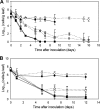Induction of viable but nonculturable Escherichia coli O157:H7 in the phyllosphere of lettuce: a food safety risk factor
- PMID: 21965401
- PMCID: PMC3233046
- DOI: 10.1128/AEM.05020-11
Induction of viable but nonculturable Escherichia coli O157:H7 in the phyllosphere of lettuce: a food safety risk factor
Abstract
Escherichia coli O157:H7 continues to be an important human pathogen and has been increasingly linked to food-borne illness associated with fresh produce, particularly leafy greens. The aim of this work was to investigate the fate of E. coli O157:H7 on the phyllosphere of lettuce under low temperature and to evaluate the potential hazard of viable but nonculturable (VBNC) cells induced under such stressful conditions. First, we studied the survival of six bacterial strains following prolonged storage in water at low temperature (4°C) and selected two strains with different nonculturable responses for the construction of E. coli O157:H7 Tn7gfp transformants in order to quantitatively assess the occurrence of human pathogens on the plant surface. Under a suboptimal growth temperature (16°C), both E. coli O157:H7 strains maintained culturability on lettuce leaves, but under more stressful conditions (8°C), the bacterial populations evolved toward the VBNC state. The strain-dependent nonculturable response was more evident in the experiments with different inoculum doses (10(9) and 10(6) E. coli O157:H7 bacteria per g of leaf) when strain BRMSID 188 lost culturability after 15 days and strain ATCC 43895 lost culturability within 7 days, regardless of the inoculum dose. However, the number of cells entering the VBNC state in high-cell-density inoculum (approximately 55%) was lower than in low-cell-density inoculum (approximately 70%). We recorded the presence of verotoxin for 3 days in samples that contained a VBNC population of 4 to 5 log(10) cells but did not detect culturable cells. These findings indicate that E. coli O157:H7 VBNC cells are induced on lettuce plants, and this may have implications regarding food safety.
Figures




Similar articles
-
Internalization and fate of Escherichia coli O157:H7 in leafy green phyllosphere tissue using various spray conditions.J Food Prot. 2014 May;77(5):713-21. doi: 10.4315/0362-028X.JFP-13-357. J Food Prot. 2014. PMID: 24780324
-
Effect of storage temperature and duration on the behavior of Escherichia coli O157:H7 on packaged fresh-cut salad containing romaine and iceberg lettuce.J Food Sci. 2010 Sep;75(7):M390-7. doi: 10.1111/j.1750-3841.2010.01722.x. J Food Sci. 2010. PMID: 21535546
-
Viable but Nonculturable Escherichia coli O157:H7 and Salmonella enterica in Fresh Produce: Rapid Determination by Loop-Mediated Isothermal Amplification Coupled with a Propidium Monoazide Treatment.Appl Environ Microbiol. 2020 Mar 18;86(7):e02566-19. doi: 10.1128/AEM.02566-19. Print 2020 Mar 18. Appl Environ Microbiol. 2020. PMID: 32005729 Free PMC article.
-
Cross-contamination of Escherichia coli O157:H7 and Listeria monocytogenes in the viable but non-culturable (VBNC) state during washing of leafy greens and the revival during shelf-life.Food Microbiol. 2023 Feb;109:104155. doi: 10.1016/j.fm.2022.104155. Epub 2022 Oct 6. Food Microbiol. 2023. PMID: 36309451
-
Salmonella spp. and Escherichia coli O157:H7 prevalence and levels on lettuce: A systematic review and meta-analysis.Food Microbiol. 2019 Dec;84:103217. doi: 10.1016/j.fm.2019.05.001. Epub 2019 May 25. Food Microbiol. 2019. PMID: 31421760
Cited by
-
Importance of Pyruvate Sensing and Transport for the Resuscitation of Viable but Nonculturable Escherichia coli K-12.J Bacteriol. 2019 Jan 11;201(3):e00610-18. doi: 10.1128/JB.00610-18. Print 2019 Feb 1. J Bacteriol. 2019. PMID: 30420452 Free PMC article.
-
Global Proteomic Analysis of the Resuscitation State of Vibrio parahaemolyticus Compared With the Normal and Viable but Non-culturable State.Front Microbiol. 2019 May 8;10:1045. doi: 10.3389/fmicb.2019.01045. eCollection 2019. Front Microbiol. 2019. PMID: 31134040 Free PMC article.
-
Recent advances in understanding enteric pathogenic Escherichia coli.Clin Microbiol Rev. 2013 Oct;26(4):822-80. doi: 10.1128/CMR.00022-13. Clin Microbiol Rev. 2013. PMID: 24092857 Free PMC article. Review.
-
Plant innate immunity against human bacterial pathogens.Front Microbiol. 2014 Aug 11;5:411. doi: 10.3389/fmicb.2014.00411. eCollection 2014. Front Microbiol. 2014. PMID: 25157245 Free PMC article. Review.
-
Predictive Population Dynamics of Escherichia coli O157:H7 and Salmonella enterica on Plants: a Mechanistic Mathematical Model Based on Weather Parameters and Bacterial State.Appl Environ Microbiol. 2023 Jul 26;89(7):e0070023. doi: 10.1128/aem.00700-23. Epub 2023 Jun 22. Appl Environ Microbiol. 2023. PMID: 37347166 Free PMC article.
References
-
- Arana I., Seco C., Muela A., Fernandez-Astorga A., Barcina I. 2003. gfp-tagged cells as a useful tool to study the survival of Escherichia coli in the presence of the river microbial community. Microb. Ecol. 45: 29–38 - PubMed
-
- Artz R. R. E., Avery L. M., Jones D. L., Killham K. 2006. Potential pitfalls in the quantitative molecular detection of Escherichia coli O157:H7 in environmental matrices. Can. J. Microbiol. 52: 482–488 - PubMed
-
- Asakura H., et al. 2002. Passage in mice causes a change in the ability of Salmonella enterica serovar Oranienburg to survive NaCl osmotic stress: resuscitation from the viable but non-culturable state. FEMS Microbiol. Lett. 212: 87–93 - PubMed
-
- Asakura H., Igimi S., Kawamoto K., Yamamoto S., Makino S. 2005. Role of in vivo passage on the environmental adaptation of enterohemorrhagic Escherichia coli O157:H7: cross-induction of the viable but nonculturable state by osmotic and oxidative stresses. FEMS Microbiol. Lett. 253: 243–249 - PubMed
-
- Asakura H., et al. 2007. Proteomic characterization of enterohemorrhagic Escherichia coli O157:H7 in the oxidation-induced viable but non-culturable state. Microbiol. Immunol. 51: 875–881 - PubMed
Publication types
MeSH terms
Substances
LinkOut - more resources
Full Text Sources
Other Literature Sources
Medical
Molecular Biology Databases

